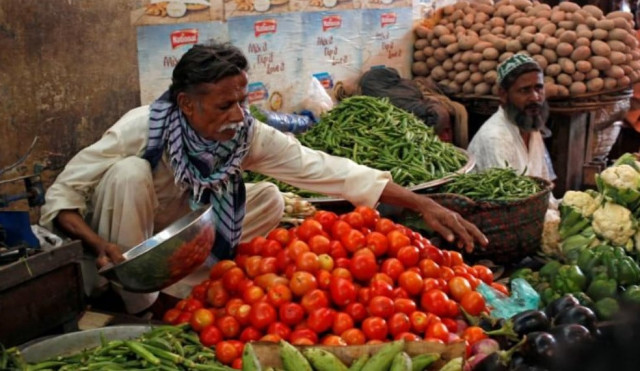April inflation may hit historic 38%
Finance ministry admits central bank’s contractionary monetary policy not working

The government on Saturday said the inflation rate might heat up to 38% in April -- which could break the country’s previous highest record.
It also admitted that the central bank’s contractionary monetary policy could not tame the inflationary expectations.
In the economic outlook for April, the finance ministry said inflation waa expected to remain in the range of 36% to 38%.
The forecast is in line with the market expectations and ground realities.
The highest inflation rate in Pakistan was recorded at 37.8% in December 1973.
However, it may soon be left behind by the recent inflationary wave that has adversely affected the majority of the country’s population.
Last month, the inflation rate was recorded at 35.4%.
Read More tax burden on rich proposed
The report, prepared by the Economic Adviser Wing of the finance ministry, also conceded that the central bank’s policies were not helping either.
“Although the SBP [State Bank of Pakistan] is enacting [a] contractionary monetary policy, inflationary expectations are not settling down,” the report read.
The SBP has increased the interest rates to a record 21% in the hope of containing the spiralling inflation, but it instead added a huge fiscal cost in the shape of higher debt servicing.
This, in turn, has been fuelling more inflation through borrowings.
The finance ministry’s latest report came on the heels of another one, which conceded that it would take time before the inflation rate slows down to affordable levels.
For the next fiscal year, the government has projected an average inflation rate of 20%.
The finance ministry reiterated that the headline inflation, measured by the consumer price index (CPI), was expected to remain at elevated levels in the months to come.
It added that its key drivers were the hike in food and energy prices.
It continued that currency depreciation and rising administered rates had contributed to jacking up the overall price level.
The ministry said global commodity prices were showing a downward trend but still on a higher side compared with the pre-Covid-19 level.
A slow recovery from flood damages have caused the supply of essential crops to remain short of domestic requirements, consequently intensifying the inflation rate.
Contrary to the government’s dilly-dallying approach to revive the International Monetary Fund (IMF) programme, the finance ministry said the successful completion of the global lender’s scheme would pave the way for attracting more capital inflows, further stabilising of the exchange rate and alleviating the inflationary pressures.
Pakistan’s economy was still facing significant challenges characterised by high inflation and a slowdown in economic activity, the report added.
The proposed medium-term economic framework has now estimated that the average inflation in the current fiscal year will remain at 28.5%, while the economic growth might slow down to 0.8%.
It expects some improvement in the agricultural sector’s conditions, including availability of inputs like seeds, loans and fertilisers.
The monthly report read that the wheat production in this fiscal year remained at 26.8 million metric tons.
However, the national food security and research ministry on Friday said the wheat production was 27.4 million tons. According to the food ministry’s estimates, 29 million metric tons of wheat will be available this year, including the carry forward stocks, but it did not report the total consumption requirements.
According to the finance ministry’s monthly report, the temperature might remain slightly above normal in most parts of the country.
A gradual rise in temperatures will accelerate the snow melt in the northern areas.
The seasonal rainfall may provide water for crops in the main rain-fed areas while the lower parts of the country will remain slightly deficient during the season of Kharif.
However, the industrial sector will remain under clouds because of the contractionary monetary and fiscal policies.
In March, the output of large industries was expected to have increased in comparison with February because of the positive seasonal effects.
However, due to the high-base effect, the year-on-year large scale manufacturing might still be marginally negative.
The trend in Monthly Economic Indicator (MEI) during the first nine months of the current fiscal year remained volatile on account of high inflation, high-interest rates, fiscal consolidation, and lack of confidence in economic agents.
The finance ministry said for the month of April, it was expected that imports would increase somewhat at a higher level against March.
It added that this was because of the government’s decision to provide some relaxation in pro-growth imports to stimulate domestic economic activities.
Read More Green-light given for 20% hike in drug prices
Remittances will remain at the same level as observed in March.
The vulnerabilities in the fiscal position have again been exposed because of the extremely poor performance of the Federal Board of Revenue (FBR).
The finance ministry said despite the improvement, risks to the fiscal sector still persisted as the FBR tax collection remained below the target because of a slowdown in domestic economic activity and import compression.
On the expenditure side, higher policy rates both at the domestic and global levels have contributed to higher mark-up payment.
This is despite the reduction in non-mark-up spending.
“Under these circumstances, the government has a daunting task to follow effective revenue mobilisation and [a] cautious expenditure management strategy to end the current fiscal year with a substantial decline in [the] fiscal deficit [in comparison with] last year,” according to the Economic Adviser Wing of the finance ministry.



















COMMENTS
Comments are moderated and generally will be posted if they are on-topic and not abusive.
For more information, please see our Comments FAQ